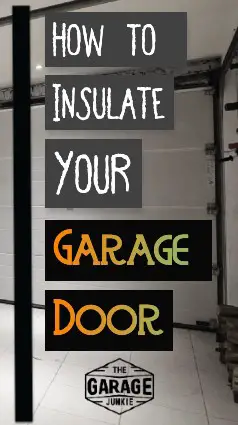So, you’ve consulted the internet for how to insulate your garage door. Considering if this job is for your mad DIY skills? Or are you thinking that this may be something to hire out? Deep breath, my friend. One of the largest factors with this kind of job is simply how much you want to get your hands dirty. If you can measure and cut, the rest will follow.
Insulating your garage door is a job that is easy enough to execute and not very time consuming, as house upgrades go. Garage door insulation also comes in standard-sized kits and sheets, making the choice of materials shopping-friendly. In addition, kits that include a vinyl backer on the insulation will make the installation look very professional. If you are still scratching your head about which way to proceed, continue reading.
Insulating your garage door is a simple project to DIY.
- Measure your garage door.
- Purchase insulation that works best with your door.
- Fit the insulation to the garage panel.
- Install the panel following the manufacturer’s guidelines.
- Check after installation to see if your garage door needs to be rebalanced.

What am I Looking for in Garage Door Insulation?
As you assess your own garage door to decide if this upgrade is for you, know that the long and short of “why” garage door insulation is to add a barrier to help keep heat from transferring in or out of your garage. This can save you money in the long run as you won’t be paying for the heat and cool to escape into the front yard.
In short, your main goal is to increase the R-value of your garage door. The R-value is the measure of thermal resistance to the flow of heat. By using an insulating material, you can reduce the transfer of heat or cold. Here are a few things you need to look out for when tackling this project.
The higher the R-value, the better the insulation is at reducing the transfer of heat or cold through the material. In general, the R-values are going to be similar.
The vinyl-backed polystyrene insulation will have a more rigid, finished look. But you will only be able to fill the panel cavity with foam, so you are limited on the amount of garage door insulation that can be used.
The batt insulation is going to be more forgiving with constraints or other mounted items that you might already have installed on your garage door (I.e. vents, stabilizer brackets, etc.). Depending on the kit you purchase, you can possibly get more R-value out of the project because the batt garage door insulation can expand beyond the frame of the garage door.
Materials for Garage Door Insulation Installations
There are different types of material available for garage door insulation. Any of the materials will work fine for you wanting to insulate your garage door and all will include a “how to” guide.
These insulative materials are polystyrene boards, batt insulation, and reflective insulation. Depending on what you purchase you may see a combination of a few of these insulative materials.
The polystyrene boards can normally come in large sheets or in smaller sizes ready to use. There are also kits that have an aluminum or vinyl backing on the polystyrene. This type will give you a cleaner installation. The thicker material will also protect the polystyrene from being punctured, making a mess, and losing its R-value. Panels most commonly range from ½ “thick (R-3.3) to 1 inch (R-6.5).
Batt insulation also comes in kits. The material is flexible and comes with a flexible vinyl cover to keep the insulation against the garage door. Using batting insulation, your kit will come with retainer clips to help keep the insulation against the garage door. Insulating values are R-3 to R-4 per inch of thickness
The reflective insulation looks like a shiny aluminum and is usually called bubble barrier since the way the product was produced looks like a bunch of bubbles, kind of like the packing material we all like to pop. This thin material reflects heat and makes it great if you are trying to combat having a hot garage. Reflective insulation has an approximate R-value of 3.5 to 6, but it depends on how it is installed, and what you are trying to accomplish (keeping heat out during those hot summers).
Garage Door Insulation Kits for Standard-Sized Doors
There are kits for each of the materials discussed above. It is recommended that you measure each panel of your garage before cutting any of the panels because it is possible for the sizes to be different from one panel to the next. When purchasing the kits, make sure that it states the coverage. This is typically found in the description if it is for a standard one- or two-car garage door.
Is Garage Door Insulation Available for Custom Door Sizes?
As stated before, measuring before you buy is the best way to start this (or any) project. Knowing your dimensions can ensure that you buy enough insulation, or that the kit you have will fit your panels correctly. In most cases though, the standard kits should be enough for most garage doors. Most of the panels will need to be sized anyway to achieve optimum fit. If the standard garage door insulation kits end up not working out with your dimensions, you can contact your manufacturer for recommendations.
What Tools are Needed for Installing Garage Door Insulation?
For most installations of garage door insulation, you will need some standard tools: Gloves, a box cutter, tape measure, safety goggles, and a straight edge (like a framing square). Check to see if the manufacturer has suggestions for any other tools in the installation process.
How to Install Garage Door Insulation
This is going to be a very “top-level” explanation for installing garage door insulation. (Meaning that some of the steps will be generalized but should help you accomplish your overall goal). Depending on the kit you purchased, the installation process, in general, will be similar. You may have a few additional steps but the general process for how to insulate any garage door is the same. Be sure to read and follow the manufacturer’s installation guide.
Step 1
Measure the garage door cavity and cut the insulation panel to fit. Give a little extra width and length when you do your initial cut. You want the panels to sit as snug as possible for both appearance and insulative capabilities. If you are using batt insulation, add the sticky pads and the first half of the retainer clip
Step 2
Cut the insulation to fit using a straight edge, like a framing square. When making your cut, position portion that will be facing into the garage on the bottom while cutting. This will give you the best cut and will help keep a straighter edge on the backer.
Step 3
Once the panels are sized and cuts completed, slide the garage door insulation into the cavity. For the polystyrene with vinyl backer or for the batt insulation, work the edges so it is secured behind the framing of the garage door. For the batt insulation, cut a small hole in the vinyl to allow the retainer clip to protrude through the batting.
Installation Tip: Lifting the garage door slightly when you are working with the lower panels can help keep the section of the door at an optimal working height during installation.
Step 4
Test the garage door opener. By installing garage door insulation, you have added additional weight that the garage door opener and spring will have to lift. I reached out to a garage door installer and repairman, and he gave me a few clues to look for to determine if you need your garage door rebalanced:
- If you raise your garage door, and it “ZOOMS” (a technical term from this installer), meaning, it goes quicker once the garage door is horizontal rather than vertical, you need to have the tension on your springs reduced.
- The more common thing that happens in this situation, since weight was added to the door, is if the door closes with a “THUD” (another scientific term). This means you will either need to have additional tension added to your current springs, or you might need to have your springs replaced to add the additional tension to safely raise and lower the door.
Contact a local professional if you suspect the door may be off-balance, or if it is straining to lift the load. New lift springs may be in order.
Final Thoughts on How to Insulate Your Garage Door
Insulating your garage is an easy and very beneficial project. Roughly one to two hours of work can extend the usability of your garage into the harsher climate seasons. Before you start, determine which garage door insulation material you are going to purchase. The kit you purchase it is going to slightly alter how you are going to install the insulation to insulate your garage good.
Lastly, once you have installed your garage good insulation, make sure the garage door closes properly. You have added additional weight to the door, which might throw the door balance off. If the garage door goes faster once the door itself is horizontal on the track, or if it closes with a thud once the garage door is closed, you need to have a professional come and rebalance your garage door.
Thanks for reading, and as always, be sure to keep it tuned to The Garage Junkie for all of your garage’s FYI and DIY needs!
